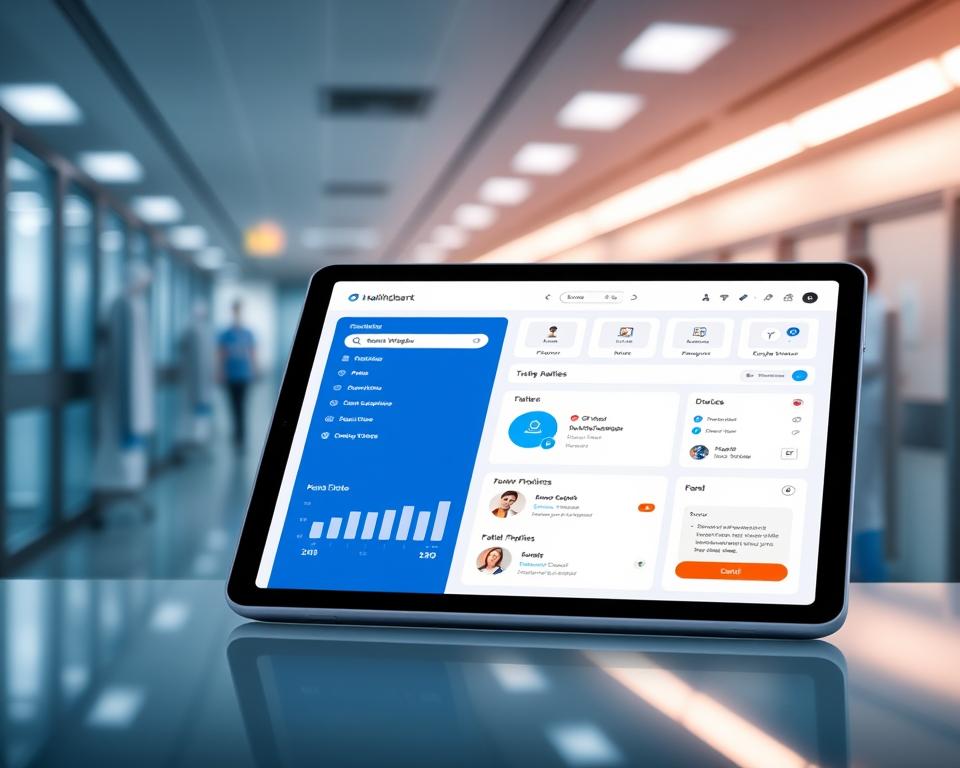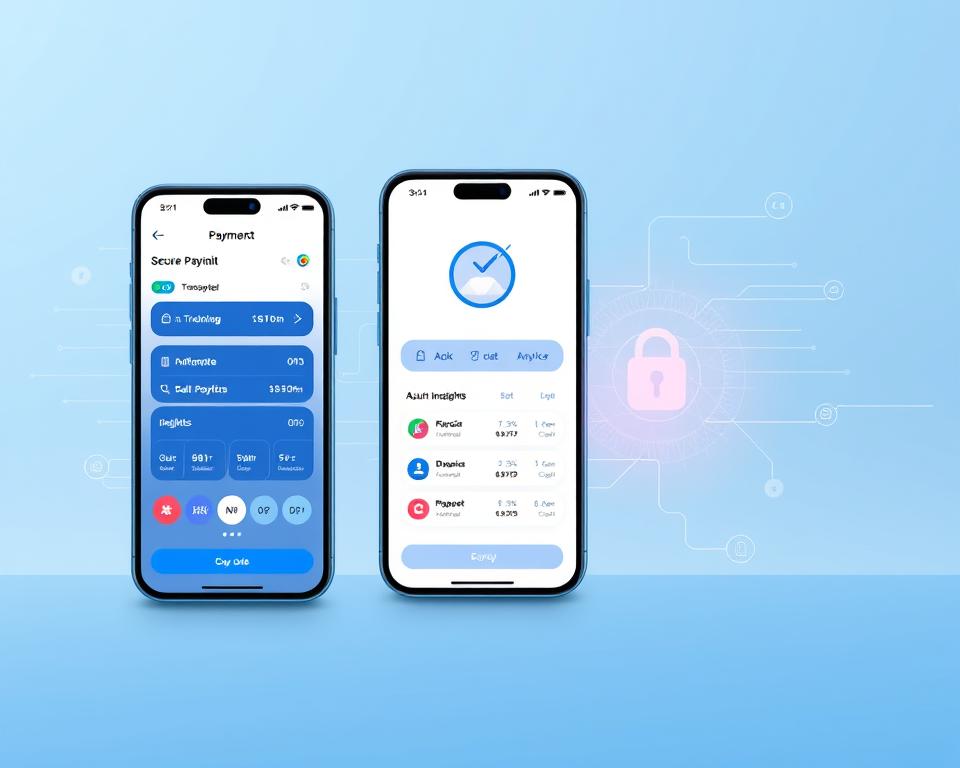In today’s competitive market, custom app development is key for revenue growth in many businesses.
Companies use tailored apps to make their operations smoother. They also improve how they connect with customers. This leads to a big increase in their profits. It’s not just about new tech; it’s about changing how businesses work with new ideas.
Here are some examples of how businesses used custom apps to see big jumps in their earnings. These stories show the power of this technology.
Table of Contents
Key Takeaways
- Custom app development can significantly drive revenue growth.
- Tailored applications enhance operational efficiency.
- Business transformation through technology is crucial for competitiveness.
- Customer engagement is a key beneficiary of custom app development.
- Innovative solutions lead to substantial revenue increases.
The Digital Transformation Imperative
Technology keeps getting better, and businesses must adapt to stay ahead. The fast change in tech has changed how companies work, talk to customers, and make money. Custom apps are key for businesses wanting to grow and improve their online presence.
Current Business Landscape and Digital Demands
The business world is very competitive today. Customers want smooth, personal experiences everywhere. 
Businesses are now focusing on digital tech to be more efficient, engage customers better, and make more money.
Why Custom Apps Are Becoming Essential
Custom apps are vital for businesses because they offer unique solutions. They help companies stand out and meet specific needs. By using custom app development, businesses can make things run smoother, improve customer service, and find new ways to make money.
As the business world keeps changing, custom apps will be crucial for digital transformation and success.
Understanding the Revenue Impact of Custom Applications
Custom applications have a big impact on a company’s revenue. They help in both direct and indirect sales. These apps are made to fit a business’s exact needs. They make operations more efficient and open up new ways to make money.
Direct vs. Indirect Revenue Generation
Custom apps can make money directly or indirectly. Direct revenue generation happens when apps let businesses sell new things, like mobile apps. Indirect revenue generation comes from making processes better, cutting costs, or boosting customer happiness. This leads to more loyal customers and keeps them coming back.
Key Performance Indicators for Measuring Success
To see if custom apps are working, businesses need to watch certain KPIs. These KPIs should match their money-making goals. Some important ones are:
- Revenue growth rate
- Customer acquisition cost
- Customer lifetime value
- Return on investment (ROI)
By keeping an eye on these KPIs, companies can see how well their apps are doing. They can then make smart choices to grow their income.
Case Study: How Businesses Boosted Revenue by3x with Custom Apps
This case study shows how businesses grew their revenue by a lot with custom apps. In today’s market, companies look for new ways to make more money. One good way is to make software that meets their needs.
Research Methodology and Data Collection
We used a mix of methods to research this. We talked to people from companies that used custom apps. We also looked at their financial reports to see how much money they made.
It took us a few months to get all the data. We learned how custom apps help businesses grow.
“Custom apps have been a game-changer for our business, enabling us to streamline operations and significantly boost revenue.” – CEO, Next Big Technology
Overview of Featured Companies
The companies in this study work in different fields like retail, healthcare, and manufacturing. Each faced its own problems. But they solved them with custom apps.
| Company | Industry | Revenue Growth |
|---|---|---|
| BuyRight Marketplace | Retail | 3.2x |
| MediConnect Solutions | Healthcare | 2.8x |
| PrecisionCraft Industries | Manufacturing | 3.5x |
These companies show how custom apps can really help businesses grow their revenue. By using software made just for them, they can solve big problems and make more money.
Retail Industry Success Story: BuyRight Marketplace
BuyRight Marketplace shines in the competitive retail world. It uses custom mobile apps to boost customer experience and sales. This story shows how they tackled challenges, found a solution, and saw their revenue soar.
Business Challenges and Objectives
BuyRight Marketplace faced hurdles that slowed its growth. Mainly, it struggled with managing inventory and keeping customers engaged.
Inventory Management Issues
They had trouble with inventory, causing stockouts and overstocking. This led to lost sales and extra storage costs. A study found that good inventory management can cut costs by up to 20%. Custom mobile apps are key to solving these problems.
Customer Engagement Gaps
They also had trouble keeping customers interested. Without personalized experiences, loyalty and retention suffered. A custom app was the answer to this problem.
Custom App Solution Implementation
The app solution for BuyRight Marketplace had important features to tackle their challenges.
Omnichannel Platform Development
They built an omnichannel platform for smooth shopping online and offline. This helped manage inventory better and engage customers more.
Personalization Features
The app included features for personalizing shopping experiences. This made shopping more enjoyable and built loyalty.
Revenue Growth Metrics and Analysis
The custom app brought big revenue gains to BuyRight Marketplace.
3.2x Revenue Increase Within 18 Months
In 18 months, revenue jumped 3.2 times. Better customer engagement and inventory management were the main reasons.
Customer Retention Improvements
The app’s personalization helped keep more customers. It made shopping more engaging and personal.
Experts say, “The retail industry’s success depends on using tech to improve customer experience and operations.” BuyRight Marketplace’s story proves this, showing how apps can boost revenue and keep customers coming back.
Healthcare Provider Case Study: MediConnect Solutions
MediConnect Solutions created a patient-focused app. This led to big wins in revenue and patient happiness.
Initial Revenue Bottlenecks
MediConnect Solutions had big problems with managing appointments and billing. These issues hurt their money-making efforts.
Appointment Management Inefficiencies
The old way of scheduling appointments was a mess. It caused many no-shows and lost money. Inefficient appointment management wasted resources and made patients unhappy.
Billing Process Challenges
The old billing system was full of mistakes. This caused delays in getting paid and higher costs. Automating the billing process was key to solving these problems.
Patient-Centered App Development Process
MediConnect Solutions made a custom app with patient needs in mind. It included telehealth and automated billing.
Telehealth Integration
The app had telehealth integration. This let patients talk to doctors online. It made patients more involved and helped MediConnect Solutions grow.
Automated Billing Features
The app’s automated billing features cut down on mistakes and sped up payments. This helped their money grow.
Financial Outcomes and Patient Satisfaction Correlation
The app brought big financial wins and made patients happier.
3.5x Revenue Growth Over Two Years
MediConnect Solutions saw their revenue grow by 3.5 times in two years after the app. This was thanks to the app’s efficiency and how it engaged patients.
Reduced Administrative Costs
Automating tasks like billing cut down on costs. This helped MediConnect Solutions financially succeed.
MediConnect Solutions’ story shows how custom apps can change healthcare and make more money.
Manufacturing Sector Transformation: PrecisionCraft Industries
PrecisionCraft Industries made a big change in the manufacturing world. They used a special ERP and workflow app. This move was to fix old problems and save money in their supply chain.
Supply Chain Inefficiencies and Cost Drains
PrecisionCraft Industries had big problems in their making process. They had delays and waste, and couldn’t see what was in stock. These issues made them less productive and cost a lot of money.
Production Delays and Waste
They often had delays, wasting resources and missing deadlines. Not being able to watch production in real time made things worse. This led to extra waste and costs.
Inventory Visibility Issues
They also had trouble keeping track of what they had in stock. This made it hard to manage their supplies. They often had too much or too little stock, making things harder.
Custom ERP and Workflow Application
To fix these problems, PrecisionCraft Industries got a special ERP and workflow app. This system had real-time production monitoring and predictive maintenance features. It helped them make their production better.
Real-Time Production Monitoring
The app let them watch their production in real time. They could see where things were slow and make changes. This helped them make better choices and work more efficiently.
Predictive Maintenance Features
The app also helped them avoid equipment failures. This reduced downtime and saved on maintenance costs. They could plan maintenance when it wouldn’t slow them down too much.
For more on how custom apps help businesses, check out Next Big Technology.
Productivity and Revenue Enhancement Results
Using the special ERP and workflow app really helped PrecisionCraft Industries. They saw a 3.1x revenue increase because they worked better and wasted less.
3.1x Revenue Increase Through Efficiency
They made more money because they worked more efficiently. The custom ERP system made their production smoother and their supply chain better.
Waste Reduction Savings
They also saved a lot of money by wasting less. The app’s features helped them cut down on waste. This saved them money overall.
Financial Services Innovation: SecurePay Solutions
SecurePay Solutions made a big splash in the financial world by going digital. They tackled customer challenges with a top-notch fintech app. This move boosted their market spot and led to big revenue growth.
Customer Acquisition Challenges
SecurePay Solutions faced tough competition in the financial market. They had to overcome two big hurdles:
Competitive Market Pressures
The financial services market is super competitive. SecurePay had to stand out with new ideas to draw in customers.
Digital Onboarding Friction
The old onboarding process was slow and off-putting. SecurePay knew they had to make digital onboarding smooth to get more customers.
Fintech App Features and Security Implementation
The fintech app they built was packed with security and was designed with the user in mind. It had some key features:
Biometric Authentication System
The app used a strong biometric authentication system for safe access. This cut down fraud risks and built trust with users.
Personalized Financial Dashboard
The personalized financial dashboard gave users a clear view of their finances. This helped users make better choices and boosted their happiness with the app.
Client Portfolio Growth and Revenue Expansion
The fintech app was a game-changer for SecurePay Solutions. They saw a big jump in clients and money coming in.
3.4x Revenue Growth Through New Clients
The fintech app helped SecurePay Solutions grow their revenue by 3.4 times. This was thanks to the app’s ability to bring in and keep new customers.
Increased Transaction Volume
The app also made it easier for users to do more transactions. This increase in activity helped grow their revenue even more.
For more on how digital banking can help, check out this guide on digital banking strategies.
Key Technologies Driving Revenue Growth
In today’s digital world, some technologies are key for boosting revenue. Companies use these to stay ahead and grow their profits.
AI and Machine Learning Integration
AI and Machine Learning are changing how businesses work. Experts say AI is now a must for any business plan. AI and ML help make smart decisions and tailor customer experiences.
AI helps improve customer service and predict trends. It also makes business processes better. For example, chatbots powered by AI enhance customer interaction, and ML finds new ways to make money.
Cloud-Based Architecture Benefits
Using a cloud-based architecture is another smart move for revenue growth. It brings scalability, flexibility, and cost savings. Companies can easily adjust to demand changes without big investments.
Cloud solutions let businesses access data and apps anytime, anywhere. This boosts teamwork, productivity, and customer happiness. It helps companies quickly seize market chances and stay competitive.
Mobile-First Design Approaches
Mobile-first design is crucial in our mobile world. It makes sure apps and websites work well on small screens and touch interfaces.
This design isn’t just about looks; it’s about a smooth user experience. Companies that focus on mobile design see better customer engagement and sales. As
By using these technologies, businesses can grow their revenue, please customers, and outdo rivals.
Implementation Strategies and Best Practices
The secret to making custom apps work is strong implementation strategies. Companies aiming to make more money with custom apps need to follow some key steps. These steps help make sure the app works well when it’s ready.
Agile Development Methodologies
Agile development has changed how apps are made and used. It lets companies work in short cycles, making changes as needed. This way, teams can show parts of the app early on, cutting down on mistakes and making the app better.
User Experience Optimization Techniques
Improving how users feel about an app is very important. Doing things like studying users, making sketches, and testing how easy it is to use helps. This makes the app easy to use and fun, which means more people will use it and be happy.
Continuous Improvement Frameworks
Keeping an app up to date is key to its success. Using frameworks for ongoing updates and checking how well the app works helps. This makes sure the app stays useful and meets what users and the company need.
By using these implementation strategies and best practices, companies can get the most out of their custom apps. This leads to lasting growth and more money.
Common Challenges and How Successful Companies Overcame Them
Businesses investing in custom app development face many challenges. These include budget limits and technical issues that slow them down.
Budget Constraints and ROI Justification
Justifying the cost of custom app development is a big hurdle. To tackle this, companies use a phased approach. They start with a basic version to see if it works before spending more.
Studies show agile methods can boost ROI. Companies can also look into custom web and app solutions to get the most value.
Technical Debt Management
Technical debt is another big challenge. It’s the cost of quick fixes that need to be fixed again later. To handle this, companies focus on making their code better and testing it often.
Regular code checks and automated tests help keep the code clean. This way, they avoid future problems and keep their code scalable.
Change Management and User Adoption
Getting employees to use new apps is key. Companies need to train and support them well. Good change management means clear talks, training, and ongoing help.
By focusing on making users happy, companies can get the most out of their apps.
In summary, while custom app development has its hurdles, successful companies have found ways to beat them. By understanding these challenges and using the right strategies, businesses can make their custom app projects a success.
Cost-Benefit Analysis of Custom App Development
Understanding the financial side of custom app development is key for businesses looking to grow through digital tools. A detailed cost-benefit analysis helps companies make smart choices about investing in custom apps.
Initial Investment Considerations
The first costs of making a custom app include several important parts. These are:
- Development costs, which cover the work of designing, coding, and testing the app.
- Technology and infrastructure costs, like the need for hardware, software, and networks.
- Human resource costs, which include the salaries and benefits of the team and project managers.
Breaking down these costs is vital for planning your budget. For example, development costs can change a lot. This depends on the app’s complexity, the tech used, and if you outsource or do it yourself.
Maintenance and Scaling Costs
After the app is made, keeping it running and growing is key. Maintenance costs include:
| Cost Component | Description | Estimated Annual Cost |
|---|---|---|
| Bug Fixes and Updates | Fixing problems and making the app better | $10,000 – $50,000 |
| Security Measures | Keeping the app safe with security protocols | $5,000 – $20,000 |
| Scalability Upgrades | Improving the app’s infrastructure for growth | $15,000 – $100,000 |
These costs can change based on the app’s complexity and how many users it has. It’s important to plan for growth. This ensures the app can handle more users without slowing down.
Long-Term ROI Calculations
To figure out the ROI of custom app development, compare the total costs to the revenue or savings from the app. A positive ROI means the investment paid off.
For example, if a company spends $200,000 on a custom app and $50,000 a year on upkeep, the total cost over three years is $350,000. If the app brings in $500,000 in revenue over the same time, the ROI is:
(Gain from Investment – Cost of Investment) / Cost of Investment * 100 = ($500,000 – $350,000) / $350,000 * 100 = 42.86%. This shows the investment was worth it.
Future Trends in Custom Business Applications
Looking ahead, custom business apps will be influenced by new technologies and changing customer needs. The next apps will offer better personalization, stronger security, and easy use across different platforms.
Emerging Technologies on the Horizon
New tech like Artificial Intelligence (AI), Internet of Things (IoT), and blockchain will shape the future of apps. AI can help make better decisions with predictive analytics. IoT can make operations more efficient by monitoring assets in real-time.
A study shows businesses using AI and machine learning get better at what they do. Forbes says, “AI is not just a tech, it’s a must for businesses.”
Changing Customer Expectations
Customers want more personalized and easy-to-use apps. Apps will need to use advanced analytics and focus on the user. Many businesses are choosing custom web development to meet these needs, as it offers more flexibility and growth.
| Technology | Impact on Customer Experience | Business Benefit |
|---|---|---|
| AI-driven Chatbots | 24/7 Customer Support | Increased Customer Satisfaction |
| Personalized Recommendations | Tailored User Experience | Higher Conversion Rates |
| Mobile Optimization | Seamless Access Across Devices | Improved User Engagement |
Competitive Advantage Predictions
To stay ahead, businesses must use new tech and listen to what customers want. By thinking ahead in app development, companies can grow and stay competitive. As
“The best way to predict the future is to invent it.”
This forward-thinking is key to success in the changing app world.
By understanding and using these trends, businesses can thrive in a fast-changing market.
Conclusion: Leveraging Custom Apps for Sustainable Growth
This article shows how custom apps can change a business for the better. Companies in retail, healthcare, manufacturing, and finance have grown a lot. They used apps made just for them.
Custom apps help businesses work better, make customers happier, and increase profits. New tech like AI and mobile design makes these apps even more powerful. This leads to lasting growth.
As the digital world gets more complex, custom apps are key for staying ahead. They help businesses compete and succeed over time. By knowing how apps can help and staying up with new trends, companies can keep growing and innovating.


















